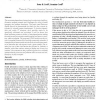Free Online Productivity Tools
i2Speak
i2Symbol
i2OCR
iTex2Img
iWeb2Print
iWeb2Shot
i2Type
iPdf2Split
iPdf2Merge
i2Bopomofo
i2Arabic
i2Style
i2Image
i2PDF
iLatex2Rtf
Sci2ools
IJMI
2007
2007
Investigating risk exposure in e-health systems
: The increasing dependency being placed on electronic health information systems presents new challenges for today’s health managers and systems developers. This paper uses Electronic Health Records to demonstrate how there are four critical attributes for e-health system development. To produce dependable and viable IT solutions, each attribute needs to be specifically addressed and prioritized. It will be shown how these attributes possess a number of interdependencies making the analysis and prioritization tasks complex and hence, in practice, often incomplete. The proposed QUiPS model aims to provide a complete framework for building trustworthy solutions. It identifies the pertinent issues and the tools and techniques needed to determine the risk exposure with a given system. The results from one of the Case Studies that focuses on Usability is detailed, while other studies relating to Safety and Privacy are outlined. The outcomes to the proposed approach are e-health systems t...
| Added | 15 Dec 2010 |
| Updated | 15 Dec 2010 |
| Type | Journal |
| Year | 2007 |
| Where | IJMI |
| Authors | Peter R. Croll, Jasmine Croll |
Comments (0)

